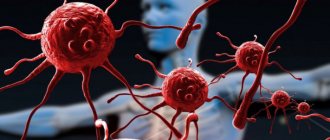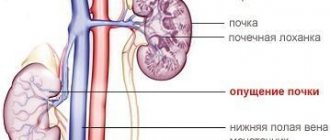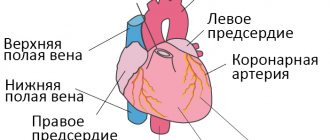Manic-depressive psychosis (MDP) is a mental disorder in which critical fluctuations in the level of vital activity and mood are observed: from depression to episodes of mania (extremely elevated mood). The diagnosis and treatment of this disorder is carried out by a psychotherapist.
The correct, modern name for MDP is bipolar affective disorder (BD).
The first signs of manic depression may be relatively mild and rare, but without timely treatment the condition quickly worsens and becomes critically acute. A person cannot think clearly, may think about suicide and behave defiantly and inappropriately. Therefore, it is important not to delay contacting an experienced psychotherapist who will stop the progression of the disease and prevent dangerous symptoms.
Factors that influence manic depression:
- Genetics - having a close relative with a mental illness (not necessarily MDP).
- Biochemistry - patients have an imbalance of neurotransmitters (normadrenaline, dopamine).
- Stressful situations - divorce or separation, violence, death of loved ones, car accident, financial difficulties.
- Alcohol abuse, drug addiction.
Most often, manic-depressive disorder occurs at a young age and, without treatment, lasts a long time, with exacerbations constantly occurring.
Diagnosis of manic-depressive psychosis
The diagnosis of the disease was first described by the French physicians Felret and Baillarger in 1854, but TIR received the status of a separate disease only in 1896. The reason for recognition as a separate nosological unit was the work of Kripelin. Then the name manic-depressive psychosis appeared. After the introduction of the international classification ICD-10, the diagnosis was called “bipolar affective disorder”.
The causes of this pathology are not precisely understood, but clinical observations indicate two potential causes of the disorder:
- congenital predisposition;
- a combination of external factors, aggravated by negative heredity.
Diagnosis is carried out in a personal conversation with a psychiatrist. The doctor studies the patient’s medical history and lifestyle. If the assumptions are confirmed, tests are prescribed. The specialist’s conversation is carried out both with the patient himself and those around him.
The onset of pathology in most cases occurs at a young age. The further development forecast is negative. If left untreated, symptoms increase. In the case of therapy and successful removal of the pathological condition, 90% of patients experience repeated attacks, requiring lifelong monitoring by a psychiatrist.
The psychiatrist identifies the presence of various stages of MDP using scales. It is necessary to exclude psychosis, schizophrenia, and psychopathy.
Manic phase of depressive psychosis
As the start of pathology, the manic phase is identified several times less frequently than the depressive state. Most patients, even at the stage of hypomania, rarely turn to specialists on their own, considering this condition to be the norm. Patients usually pay attention only to increased activity, which they perceive rather positively.
Characteristic manifestations become:
- increased disinhibition;
- unhealthy shine in the eyes;
- circumlocution;
- the present, future and past are perceived in rainbow colors;
- increased level of perception of one’s own strength and attractiveness;
- unhealthy optimism and a sense of limitlessness of one’s own possibilities.
The patient notices all the little things. He strives to communicate, notices all the little things. Tends to contact people without assessing the adequacy of the communication initiated, memory improves. A characteristic feature is an excessively positive perception of new acquaintances and emerging dissatisfaction with representatives of the close environment. In relation to the latter, the patient often becomes overly demanding and capricious.
The manifested disinhibition often becomes the reason for committing rash acts, sexual promiscuity, and inadequate financial spending.
Manifestations of the stage in children are poorly described, as they are less common. Young patients suffer from hyper-reactivity, they are verbose and agitated.
Consequences of hypomania
Often the disease progresses to the stage of minor depression or subclinical depression. In terms of severity, it does not correspond to the formal standards of the classifier (ICD10). A negative background is accompanied by a loss of strength. There are cases when it is impossible to recognize the disease, that is, short manic episodes alternate with a normal state. A long or continuous course of the disease exhausts relatives who surround such a person with excited emotions. Typically, such behavior becomes a reason for loved ones to seek help from a specialist.
Signs and symptoms of manic depression
The leading symptom is an increased level of activity, rapid thinking, and motor agitation. The need for sleep decreases, while desire and sexual activity increase. This state passes, giving way to entering a depressive state and a gloomy perception of the world around us. The duration of each period in most cases is several days. There are stages with a high duration of the patient’s stay in a manic or depressive state.
Changes in states lead to disruption of social adaptation. In the initial stages, the patient surprises those around him with changes in his active desire to communicate, which sharply gives way to a negative attitude. The patient’s sense of self, accompanied by the recognition of a health disorder, occurs at the depressive level of the pathology. As the disease progresses, changes in activity become frequent and increasingly noticeable to others.
In severe mania, there may be a high level of violent tendencies. Thinking becomes spasmodic. Hallucinations and delusions similar in type to those characteristic of schizophrenia may occur.
The symptoms of a depressive state are completely opposite to the manic stage. With the agitated type, motor retardation is noted. In the case of anesthetic depression, the patient's feeling of painful insensibility is dominant. The emptiness that arises in place of each of the senses leads to painful perception. Sexual attraction at this stage, on the contrary, is completely absent.
Treatment of manic-depressive psychosis
The first step of therapy is the elimination of provoking negative external factors. This, first of all, refers to the onset of pathology against the background of prolonged drug or alcohol intoxication, which often becomes the trigger for MDP. It is necessary to eliminate other stressful cases that are traumatic to the patient.
Types of therapy differ depending on the stage. Antidepressants are recommended in case of depression, combined with mood stabilizers and atypical antipsychotics. The dosage is determined individually for each patient. The prescription is carried out only by a doctor, since there is a risk of provoking the transition of a depressive state to a manic state.
The exit from the manic stage is carried out by prescribing mood stabilizers. Antipsychotics are additionally included in severe stages.
With a properly selected course of therapy, patients recover completely, but the unfavorable prognosis is confirmed by the alternation of periods of remission with attacks of the disease. Return of the diagnosis is observed in 90% of patients. In case of a complex course, therapy is possible only in a hospital setting. Mild stages can be treated using outpatient treatment.
About 30% of patients do not go into remission. Most often, this course of diagnosis is observed in patients with alcohol or drug addiction. MDP is often accompanied by other psychiatric diagnoses.
Reasons for development
Many of us have found ourselves in situations where we need to give it our all. In an effort to finish work on time, a person without mental disorders may also become hyperactive. But after the project is completed, he will try to rest and get some sleep. The presence of pathology may be indicated by a person’s inability to relax; he is unable to force himself to rest.
Pathological hyperactivity can occur for several reasons:
- As a result of hormonal imbalance, the main symptoms of hypomania can be observed. Mood disorders occur when the thyroid gland is not functioning properly. In addition, hypomania can occur in women after childbirth or during menopause;
- short-term episodes of hypomania can occur against the background of eating disorders or fasting for the purpose of recovery. Elation occurs against the background of food excitement;
- Hypomanic behavior may result from the use of certain pharmacological agents. Baclofen, bromine-containing drugs, opiates, corticosteroids, and hallucinogens can lead to such consequences. Episodes of hypomania can also develop against the background of abrupt withdrawal from antidepressants;
- mood can become pathologically high due to the use of large doses of all kinds of stimulants and narcotics (coffee, energy drinks, cocaine, etc.);
- hypomania may be a consequence of organic brain damage caused by various neuroinfections and injuries;
- The most likely cause of episodes of mild mania is a personality disorder called bipolar disorder (BD). Hypomania is one of the phases of this disorder. Why some people develop bipolar disorder is still not completely clear, but a relationship has been established between hereditary factors and the likelihood of this disorder.
Hypomania can be an independent pathology, but in some cases such conditions are a background or component of other (for example, hysterical and psychosomatic) disorders. The success of therapy depends on how accurately the doctor determines the reasons that led to such inappropriate behavior of the patient.
Disease manic depressive psychosis
The complexity of diagnosing and treating MDP is complicated by the presence of different types of manifestation of the diagnosis.
Affective psychoses, manic depressive psychosis
Affective psychoses become a frequent manifestation of MDP. These somatic disorders complement a large number of somatic and mental diagnoses. They are not identified as an independent nosological unit, which led to their inclusion in the MDP. The main manifestation is a state of habitual melancholy.
The patient is depressed, but not accompanied by sudden mood swings. It starts without obvious provoking factors. Attacks of severe melancholy often start after severe psycho-emotional trauma. The pathology is often diagnosed as “reactive depression”. Hereditary factors play a major role in the occurrence of pathology. Severe brain diseases can also be a provocateur.
Bipolar disorder, manic depressive psychosis
MDP in such a situation manifests itself in the form of the described obvious manifestations of manic-depressive disorder. Patients suffer from sudden changes in states of increased activity and lethargy.
During a manic state, there is increased excitability and sexuality. Patients are literally “gushing” with ideas, which are often unrealizable and unfulfillable. They are hyperactive and need to communicate with others. Mental activity is fragmented, patients are verbose and often obsessive.
During periods of depression, complete apathy occurs. Sexual activity disappears until complete rejection. The level of drowsiness increases, movements slow down. Patients often prefer to remain in a stable, static state, do not get out of bed, stop going to work or school, and exclude contact with the outside world. A frequent manifestation is the appearance of thoughts about the meaninglessness of existence and suicide.
Bipolar manic depressive psychosis
This condition is characterized by an increased level of symptoms on the verge of disruption of all vital functions. A patient in the depressed stage is expected to have a difficult, often shameful, diagnosis. Psychosis is accompanied by a change in activity on the verge of a desire to harm others with deep depression and denial of all life's demands and desires.
Manic depressive psychosis in women
A complex psychological disease of an autosomal dominant type is most often currently diagnosed in the fairer sex. Diagnosis can be slowed down due to the prevailing social idea that women are prone to mood swings and hysteria. They refuse to acknowledge the presence of pathological disorders for longer.
Changes in intensity are often associated with hormonal factors that can become provocateurs in reality, but are not necessarily the cause of the disorder. Female patients are more prone to long periods of depression followed by short-term moments of manic activity. Periods of a significant drop in interest in life with the emergence of a desire to harm oneself, even to the point of suicide, are replaced by increased activity, the woman makes rash contacts, and is prone to irregular and unreasonable financial expenses. The disease in women can remain in a latent state for a long time.
Signs and symptoms of manic depressive psychosis in women
MDP in women is accompanied by sudden mood swings. States of increased activity and desires to perform impulsive actions, followed by moments of deep depression. The duration of the conditions varies from several days to several weeks, with a predominance of depressive moments.
Manic depressive psychosis in men
It is in men that the onset of the disease often occurs at the manic stage. Society at the initial stages has a positive perception of mental and physical activity, calling it business acumen and production boost. Further, the manic stage can turn into an aggressive state.
Depression in men is also more complex, often accompanied by periods of the patient being in a state close to catatonia. Against the background of MDP, a man is more likely to make successful suicide attempts.
Signs and symptoms of manic depressive psychosis in men
The majority of men perceive the state of euphoria positively, recognizing it as a manifestation of positive activity. Men become very sociable with strangers, often make acquaintances with antisocial elements, and mania moves to the stage of aggression more often than in women.
The depressive period is characterized in men by thoughts and aimlessness of existence, an active rejection of work activity of any type, there is often a tendency to alcoholism, antisocial habits, and thoughts of suicide appear.
Differences between males and females
If you believe the statistics, men get sick less often than women. Ratio: 3:2. The female part of the patients is characterized by a rapidly cyclical nature of the disorder. Women have low sensitivity to therapeutic methods. They have a higher risk of suicidal behavior and a higher rate of hospitalization. The symptoms of bipolar disorder in men are practically no different from the manifestations of the disorder in women.
Minor differences - in the male part of the patients the phases of mania and hypomania predominate, and in the female part - depressive states. Symptoms of depression in women are much more pronounced.








